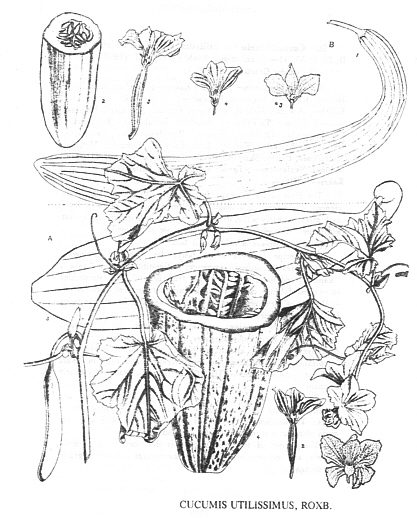

Zitierweise / cite as:
Carakasaṃhitā: Ausgewählte Texte aus der Carakasaṃhitā / übersetzt und erläutert von Alois Payer <1944 - >. -- Anhang A: Pflanzenbeschreibungen. -- Cucumis melo L. subsp. melo var. conomon (Thunb.). -- Fassung vom 2007-07-27. -- URL: http://www.payer.de/ayurveda/pflanzen/cucumis_melo.htm
Erstmals publiziert: 2007-07-27
Überarbeitungen:
Anlass: Lehrveranstaltung SS 2007
©opyright: Dieser Text steht der Allgemeinheit zur Verfügung. Eine Verwertung in Publikationen, die über übliche Zitate hinausgeht, bedarf der ausdrücklichen Genehmigung des Verfassers
Dieser Text ist Teil der Abteilung Sanskrit von Tüpfli's Global Village Library
Falls Sie die diakritischen Zeichen nicht dargestellt bekommen, installieren Sie eine Schrift mit Diakritika wie z.B. Tahoma.
Verwendete und zitierte Werke siehe: http://www.payer.de/ayurveda/caraka0001.htm

Abb.: Cucumis
melo L. subsp. melo var. conomon (Thunb.) Makino = Gemüsemelone
[Bildquelle: Kirtikar-Basu, ©1918]
Drury:
"Cucumis utilissimus (Roxb.) N. O. Cucurbitaceae. Field Cucumber, Eng. Kakrie, Hind. Kankoor kurktee, Beng. Doskai, Tel.
Description.—Trailing; stems scabrous; leaves broad-cordate, more or less 5-lobed; lobes rounded and toothed; male flowers crowded, females solitary; fruit short, oval, when young pubescent, when old glabrous, variegated; flowers yellow. Fl. Nearly all the year.— W. & A. Prod. i. 342.—Roxb. Fl: Ind. iii. 721.-------Cultivated.
Economic Uses.—The fruit is pickled when half grown, and when ripe and hung up it will keep good for several months. The seeds contain much farinaceous matter mixed with a large proportion of mild oil. The meal is an article of diet with the natives, and the oil is used for lamps. Roxburgh has the following remarks upon this plant: " This appears to me to be by far the most useful species of Cucumis that I know: when little more than half grown, the fruits are oblong and a little downy—in this state they are pickled; when ripe, they are about as large as an ostrich's egg, smooth and yellow. When cut they have much the flavour of the Melon, and will keep for several months, if carefully gathered without being bruised, and hung up. They are also in this state eaten raw, and much used in curries by the natives. The seeds, like those of other Cucurbitaceous fruits, are nutritious; the natives dry and grind them into a meal, which they employ as an article of diet; they also express a bland oil from them, which they use in food and burn in their lamps. Experience as well as analogy proves these seeds to be highly nourishing, and well deserving of a more extensive culture than is bestowed on them at present. The powder of the toasted seeds mixed with sugar is said to be a powerful diuretic, and serviceable in promoting the passage of sand or gravel. As far as my observation and information go, this agriculture is chiefly confined to the Guntoor Circar, where the seeds form a considerable branch of commerce. They are mixed with those of Holcus sorghum, or some others of the large culmiferous tribe, and sown together: these plants run on the surface of the earth and help to shade them from the sun, so that they mutually help each other. The fruit, as I observed above, keeps well for several months if carefully gathered and suspended. This circumstance renders it an excellent article to carry to sea during long voyages."—(Roxb.) The C. pseudocolocynthis found on the slopes of the Western Himalaya is a good cathartic. It is called the Himalayan Colocynth.—(Royle.) The C. momordica is an article of diet, and a good substitute for the common Cucumber, which is also cultivated to a great extent in India.—(Roxb.) Two other plants of this natural order may be mentioned here—the Cucurbita pepo, the well-known Pumpkin, which is reputed to possess anthelmintic properties in its seeds useful in cases of Taenia. The fruit is very common in India, in which case the remedy, if really effectual, might be readily available. The other is the G. maxima, which would appear to possess similar properties, and to have been successfully applied in cases on record.—Pharm. of India."
[Quelle: Drury, Heber <1819 - 1872>: The useful plants of India : with notices of their chief value in commerce, medicine, and the arts. -- 2d ed. with additions and corrections. London : Allen, 1873. -- xvi, 512 p. ; 22 cm. -- s.v.]